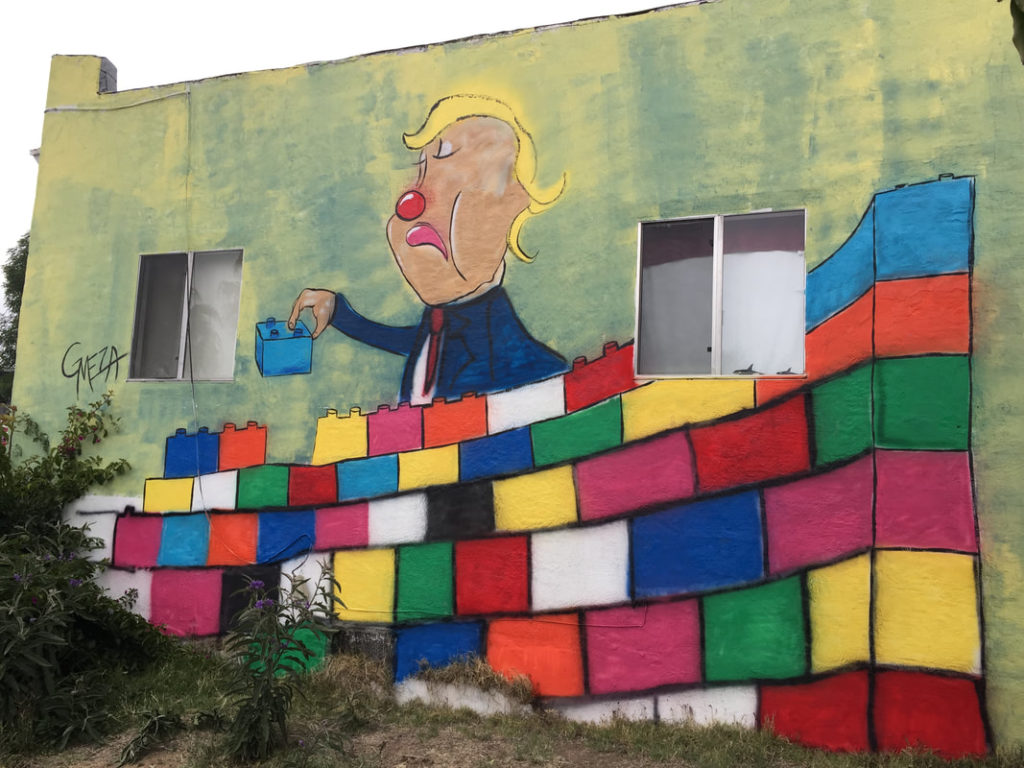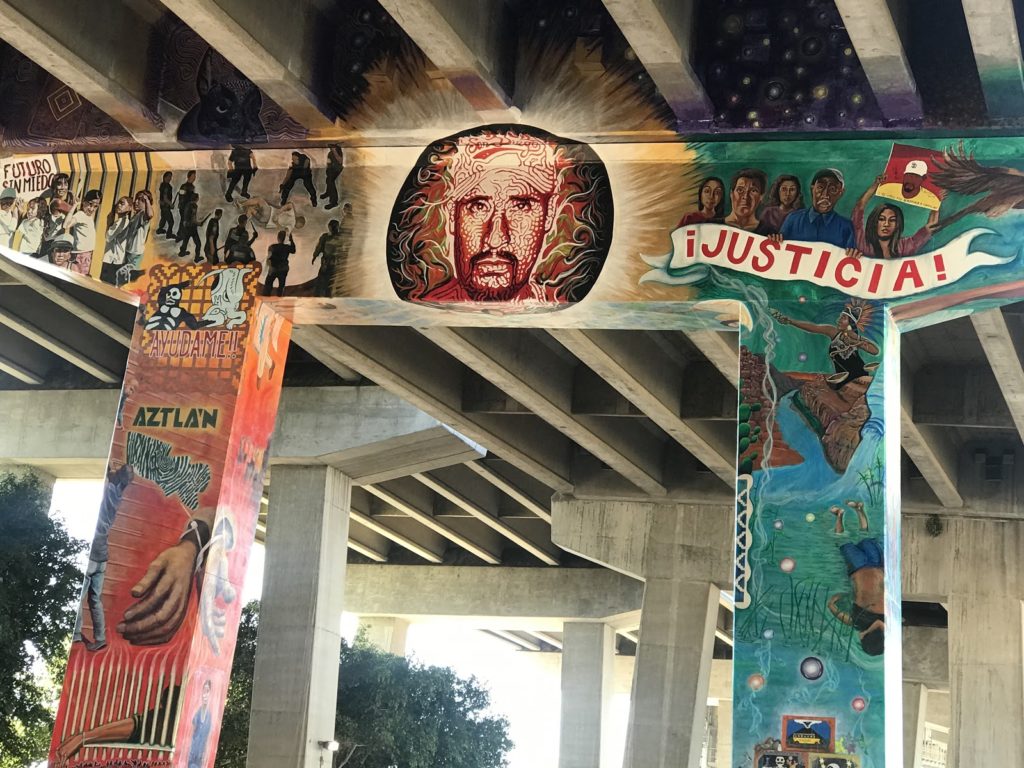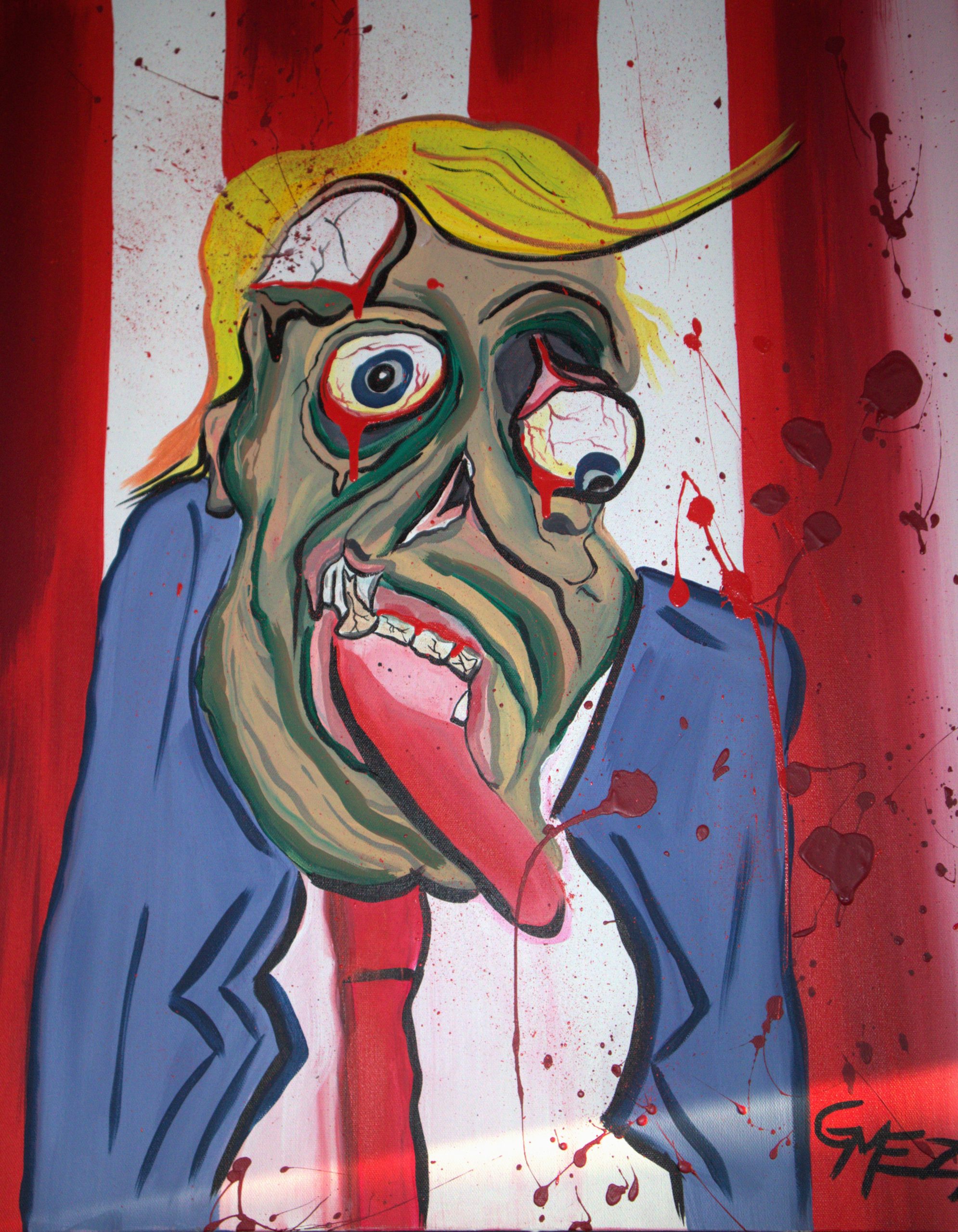Written by: Bianca Huntley Ortega
Featured art: Gerardo Meza
They say the eyes are the windows to the soul. If that is true then Gerardo Meza’s paintings must be the windows into his surrealist Mexican American dream.
Meza, the accomplished fronterizo muralist and painter, has been commissioned to paint in major cities across California and Mexico. Another important space he has worked in is San Diego’s cherished Chicano Park. The park was part of a community takeover in 1970, and has since become a National Historic Landmark and home to a large collection of outdoor murals dedicated to Chicano and Mexican American cultural heritage.
His solo art exhibit titled “Gerardo Meza’s Imaginarium” was located at Blk Box Gallery in San Ysidro, California and showcases Meza’s innermost thoughts and social commentaries.
On opening night of Meza’s Imaginarium, those in attendance spilled out onto the sidewalk, a positive sight for Abraham Valdez and Ernesto Gonzalez, two of the five gallery founders.
The success of the opening reflects what the founders of Blk Box said the community wants and needs, art. The non-traditional black walled gallery is trying to fill that void by featuring talent from the community.
The founders of Blk Box have held events for other local artists, and over time they kept hearing Meza’s name. After meeting with him the gallery started planning his solo showcase.
Valdez, a videographer, said he was drawn to Meza’s style because each painting is like its own dream.
“Everybody has their own different imagination, but it’s crazy to see the insight into his own imagination,” he said. “It scares you, but at the same time it intrigues you, and it brings you in.”
Gonzalez, also in video production, said what he likes about Meza’s work is there’s more to it than what first meets the eye. What looks like an innocent rabbit or teddy bear is much more in terms of symbolism.
“It gets to a sort of surreal space in your mind that you’re getting to know the artist in a very deep way,” he said. “There’s also a lot of cultura involved in his work.”
All of Meza’s paintings are influenced by his Fronterizo experience, struggle and cultural upbringing. Some of his works in this exhibit analyze the political issues enveloping the community today.
The piece titled “Cultural Baggage” shows a calm and collected man smoking a cigarette while standing over a visibly battered woman. It comments on the gendered violence against Mexican and Mexican American women that takes place on both sides of the border.

Meza said he was trying to explain how Mexican and Mexican American culture share the practice of having very defined male and female roles. A practice shown and normalized through the timeless golden era of Mexican film.
“We saw that in the Pedro Infante movies. The macho has like three or four women and he hits them,” Meza said. “It is something that we need to analyze. It’s something that is wrong, what is happening to women right now.”
Another political piece titled “I’ll Be Back to Mess With Your Brains,” depicts a zombie Donald Trump standing in front of red and white vertical stripes. Meza said the racist rhetoric and actions Trump brought out in his base has stuck around and does not appear to be going away any time soon.
“I think we all feel safe, we feel really good,” but Meza cautioned, “He’ll be back in one form or another.”
This is not the artist’s first time painting the polarizing president. Meza gained recognition for his mural “Lego Wall,” where a cartoon version of Trump is shown building a border wall with the popular building blocks from America’s childhood.

This latest exhibition is a window into the current issues impacting the Chicano, Mexican American and Fronterizo communities who live on the borderlands of San Diego, and how those experiences are shaping their art scene.
Victor Ochoa was one of the attendees. The renowned muralist, activist artist and co-founder of Centro Cultural de la Raza, said the themes in Meza’s work connect him to the artist. Ochoa’s art and murals, some located in Chicano Park, also touch on political issues and binational experiences.
“Gerardo I think he’s an important figure here at the border, because we cross back and forth,” Ochoa said. “It’s like bumblebees, we sort of pollinate both sides of the border.”
For Ochoa it is important for binational artists to be able practice their art and build community on both sides of the border. In his eyes, Meza has done a great job of creating a network of border artists across ages.
The long-established Chicano artists are finding themselves turning their focus towards developing younger artists to one day take over the practice and evolution of Chicano and Fronterizo art. Ochoa and Meza both look to mentor the youth.
“As I’m getting older, I see that it’s even more important to make sure that we have people ready to keep the torch,” Ochoa said. “Because we Chicanos from the 60s we felt that we were carrying the torch of the Mexican muralists in Mexico.”
Ochoa met Meza nearly ten years ago and fostered an artist relationship. They eventually got a chance to paint together. Ochoa was made the lead artist of the Anastasio Hernández-Rojas mural, the newest mural in Chicano Park, and Meza worked with him.

The piece captures the story of Anastasio Hernández-Rojas, a San Diego resident who was brutally beaten and tased by United States Customs and Border Protection personnel. His death was labeled a homicide by the San Diego coroner’s office, but no criminal charges were filed against the border patrol agents involved.
The mural and memorial acts as a present day reminder of the struggle for justice. The double-sided 50 foot pillars tower over what was once a blank small-scale canvas. Ochoa suggested that Meza paint on the electrical utility box nearby.
On one side Meza depicted the abuse of power that ultimately killed Hernández-Rojas. On the other side are themes Meza is better known for when using this medium. Animals, like palomas, and Mesoamerican imagery.
Painting on electrical boxes is something Meza has continued doing with Border Public Art Committee, along with other artists and local youth. The organization brings beautiful bright murals to the busy street known as San Ysidro Boulevard which runs along the US/Mexico border.
As a leading member of BPAC (Border Public Art Committe), Meza finds local artists to create masterful murals and brings community members together in beautifying San Ysidro, a transnational neighborhood. They put up art on empty walls, public utility boxes and anywhere else building owners welcome them to paint.
While preparing for his exhibit late at night Meza often found curious teenagers and people peeking in and wondering what was going on. He invited them in to come and watch him practice his art. For some of his neighbors, he said, it is something they have never seen before.
It underlined Meza’s message to the community with his latest art exhibit.
“We wanted to bring art to the community,” he said, “ to let our people know that they can pursue their dreams, whatever they are.”
After entering Meza’s Mexican American surrealist dreams one can only ask, what are mine? While the San Ysidro community ponders, the Chicano and fronterizo art space at BlkBox along with artists like Meza are just waiting to see where young people’s dreams may take us all.
Bianca Huntley Ortega is an educator and writer based in Southern California. She aims to teach and write on topics from an Ethnic Studies perspective whenever possible. Through her work with young people and volunteering on the weekends she hopes to help students learn more about past community lessons and participate in making history in the present.

